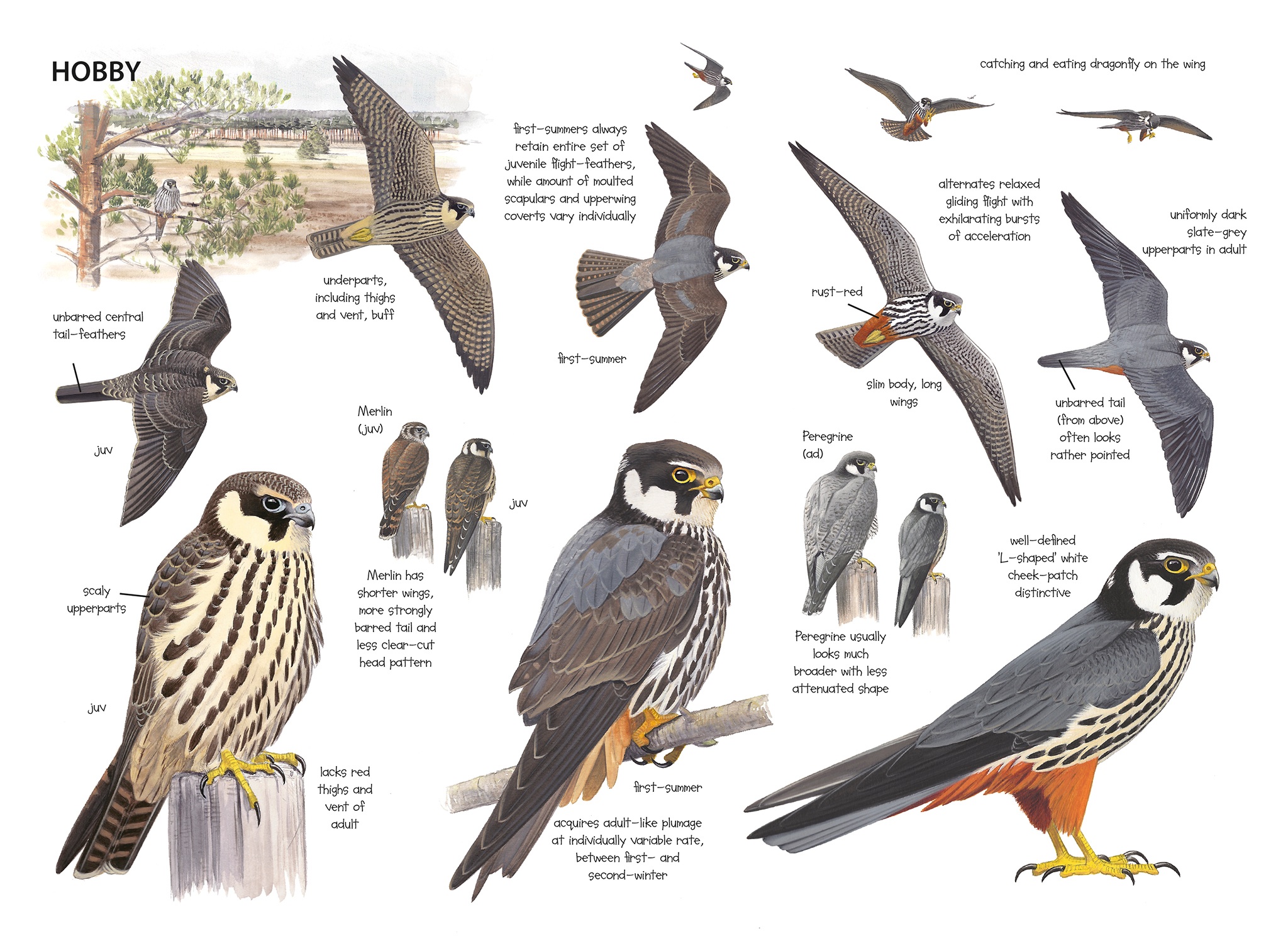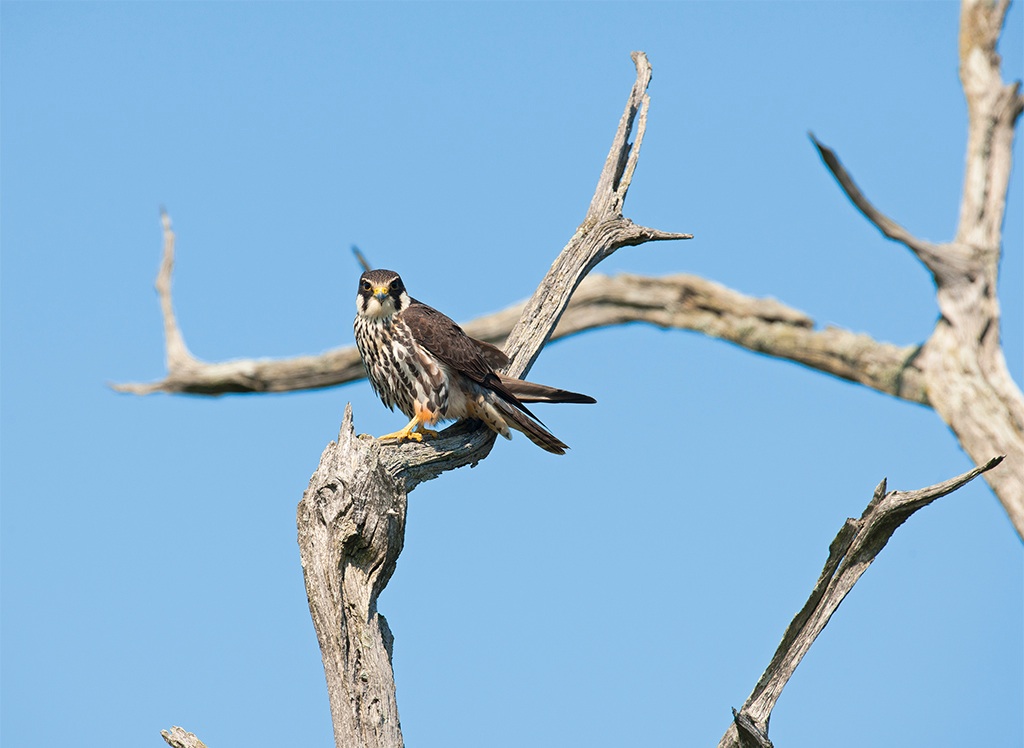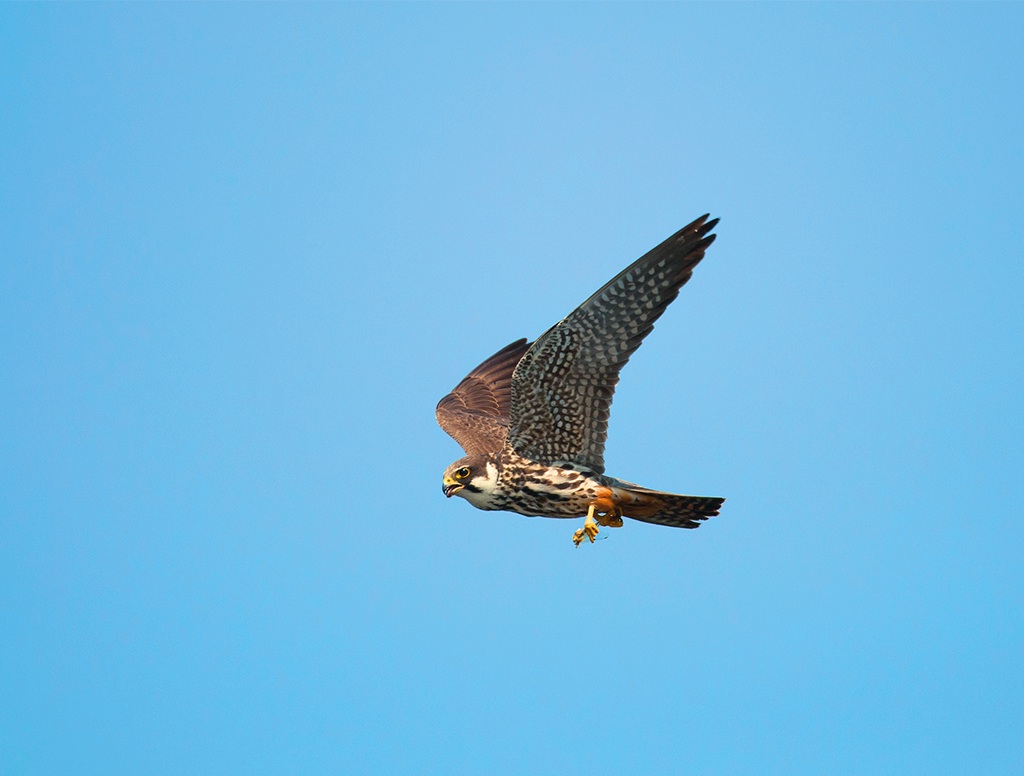
While we are dealing with my anxieties, we might as well cover this one. I think I have a deaf spot when it comes to Hobby calls, but I can’t be sure. Let me show you what I mean. Imagine that you are walking with me from the hide at Middlebere along the track towards Hartland Moor, then along the old tram track up to Soldier’s Road. There are 10 sounds that you hear. Without scrolling further down the page, have a listen to each sound (CD2-81). Hobby is featured twice, an adult male and a pair. Each of these species has been seen or heard over the years along this route, some more often than others. If you can identify more than half, you are doing better than anyone did when we tried this at the pub.
CD2-81

Eurasian Hobby Falco subbuteo, first-summer, near Sherford Bridge, Dorset, 16 June 2010 (Mike Coleman). Each year in June, first-summer Hobbies appear in the south of England. The one in this picture can be distinguished from an adult by the tar-brown upperwing with indications of retained scaling, and also the distinct barring to the undertail. These first-year birds need to be taken into account when doing a Hobby census.
CD2-81a: Common Greenshank Tringa nebularia Middlebere, Dorset, England, 31 August 2002. Calls of a migrant preparing to take off. Background: Eurasian Curlew Numenius arquata. 02.040.MR.01249.22
CD2-81b: Osprey Pandion haliaetus Raso, Cape Verde Islands, 13:13, 21 March 2007. Calls of a pair. Background: Raso Lark Alauda razae. 070321.MR.131303.31
CD2-81c: Lesser Spotted Woodpecker Dendrocopos minor Castelo Branco, Portugal, 08:38, 1 July 2010. Song. Background: Spanish Imperial Eagle Aquila adalberti, Spotless Starling Sturnus unicolor and Spanish Sparrow Passer hispaniolensis. 100701.MR.083808.20
CD1-81d: Eurasian Hobby Falco subbuteo Hoge Vuursche, Utrecht, Netherlands, 3 August 2004. An adult calling to a fully grown juvenile on the nest, perhaps encouraging it to take its first flight. Background: Common Buzzard Buteo buteo, European Blue Tit Cyanistes caeruleus and Short-toed Treecreeper Certhia brachydactyla. 04.039.MR.11412.01
CD2-81e: White-tailed Eagle Haliaeetus albicilla Pyhäjärvi Lake, Yläne, Finland, 7 March 2003. Calls of a five-year-old female at a feeding station. Background: 03.004.MC.01300.01
CD2-81f: Eurasian Wryneck Jynx torquilla Białowieża, Podłaskie, Poland, 09:30, 28 April 2003. Song of a pair. Background: Common Starling Sturnus vulgaris 03.013.MC.04200.01
CD2-81:g: Common Kestrel Falco tinnunculus Cesaro, Sicily, Italy, 18:27, 3 May 2010. Calls of an adult flying close to the pinnacle it was breeding on. Background: Eurasian Wren Troglodytes troglodytes, Common Nightingale Luscinia megarhynchos, Common Blackbird Turdus merula and Corn Bunting Emberiza calandra. 100503.MR.182740.01
CD2-81h: Green Woodpecker Picus viridis Arne, Poole Harbour, Dorset, England, 20 April 2008. A yaffle or ‘laughing’ call. Background: Common Teal Anas crecca, Eurasian Wren Troglodytes troglodytes, Song Thrush Turdus philomelos and Willow Warbler Phylloscopus trochilus. 08.011.MC.00350.01
CD2-81i: Eurasian Hobby Falco subbuteo Lentevreugd, Zuid-Holland, Netherlands, 22:18, 30 June 2004. Staccato calls of a pair circling over a marsh at dusk. Background: Egyptian Goose Alopochen aegyptiaca. 04.021.AB.02533.13
CD2-81j: Peregrine Falcon Falco peregrinus Soldier’s Road, Poole Harbour, Dorset, England, 17:00, 24 January 2004. An interaction between two birds at dusk, with keCHEK calls. One of them had prey and the other was seen flying off towards a roost. 04.003.MC.00050.41
The last two don’t sound much like the others, but show that there is even potential for confusion between Hobby and Peregrine. I actually recorded that pair of Peregrines interacting at dusk one winter on Soldier’s Road, where you can see Hobbies a few months later.
Maybe I just don’t hear enough of the real thing, and yet with about half a dozen pairs of Hobby in the harbour I get to see them often enough. The adults arrive in May, while some yearlings pop back in June for a bit of prospecting. Other young Hobbies stay on their wintering grounds, or else move north but not far enough to reach Poole Harbour.
So how can we tell Hobbies apart from some of the species that give similar sounds? Wryneck can sound very similar indeed, and although they are rare in the harbour, the potential for confusion does exist. Magnus tells me that the more Wryneck-like examples of Hobby in our collection all start with an acceleration, coinciding with a slight rise in pitch. In other words, at the start of a call the notes become progressively shorter and higher-pitched before stabilising. You can hear this clearly in CD2-82, a male and female calling in turn having recently returned to their breeding grounds. In Wryneck, there is a slight rise in pitch too, but none of our recordings show an obvious acceleration. If anything there is sometimes a slight deceleration, the first note or two being noticeably shorter, as if the bird stutters to get started. You can hear this from a male and female calling in alternation in CD2-83.
CD2-82: Eurasian Hobby Falco subbuteo Aksu-Dzabagly zapovednik, South Kazakhstan, Kazakhstan, 5 May 2000. Courtship of a pair. Background: Water Pipit Anthus spinoletta and Eurasian Magpie Pica pica. 00.021.MR.04414.11
CD2-83: Eurasian Wryneck Jynx torquilla Białowieża, Podłaskie, Poland, 08:10, 28 April 2003. Courtship of a pair. Background: Eurasian Blackcap Sylvia atricapilla, Common Chiffchaff Phylloscopus collybita, Eurasian Starling Sturnus vulgaris, Common Chaffinch Fringilla coelebs and Hawfinch Coccothraustes coccothraustes. 03.013.MC.02400.01
Of the other species you listened to, Kestrel is a common relative of Hobby, allowing plenty of opportunities both for mistakes and learning. Some of the faster call types of Hobby are similar in pitch and repetition rate to Kestrel calls, and one way to tell them apart is to listen carefully to the individual notes. In Hobby, each note in the faster call type descends sharply in pitch (CD2‑84). This is not the case with Kestrels, where if anything, each very short note sounds as if it rises rapidly (CD2-85). In fact the pitch then goes down again, but this is hardly audible. As the example shows, Kestrels also tend to have a slightly harsher timbre.
CD2-84: Eurasian Hobby Falco subbuteo Hoge Vuursche, Utrecht, Netherlands, 3 August 2004. Calls of a juvenile female followed by a more distant alarmed adult. 04.039.MR.10840.00
CD2-85: Common Kestrel Falco tinnunculus Merja Zerga, Moulay Bousselham, Morocco, 06:35, 7 October 2006. Calls of a female, given during a display flight with fast and fluttery wingbeats. Background: Eurasian Collared Dove Streptopelia decaocto, Common Bulbul Pycnonotus barbatus, Common Blackbird Turdus merula and European Goldfinch Carduelis carduelis. 06.014.AB.03703.01.

Eurasian Hobby Falco subbuteo, first-summer, near Sherford Bridge, Dorset, 4 June 2010 (Mike Coleman). Superficially similar to adults, first-summer Hobbies are best identified by the brownish, juvenile upperwing and the distinctly barred juvenile tail-feathers (best seen from below). Note also on this bird, that the reddish colour below is restricted to trousers only and that the trousers are boldly marked, although both of these features vary individually.
Hobbies also have a very short kip call that is shared by several other falcon species. In CD2-86 it is given by an adult, as a response to several other Hobbies flying over its territory. Very young Hobbies still on the nest can be identified by the weaker, scratchier quality of their calls (CD2-87). The sound we hear most often from Hobbies is a far-carrying, insistent pee-pee-pee, as in CD2-88, although we don’t usually hear it with White-tailed Eagles in the background. I should explain that it was Dick Forsman who made the last two recordings, near his holiday home in the southwest corner of Finland. I wouldn’t mind hearing either of these raptors more often in Poole Harbour.
CD2-86: Eurasian Hobby Falco subbuteo Hoge Vuursche, Utrecht, Netherlands, 3 August 2004. An adult responding to at least three intruders of the same species flying high overhead. Background: Great Spotted Woodpecker Dendrocopos major, Great Tit Parus major and Eurasian Nuthatch Sitta europaea. 04.039.MR.02406.11
CD2-87: Eurasian Hobby Falco subbuteo Hanko, Uusimaa, Finland, 07:00, 30 July 2006. A juvenile calls weakly from the nest. Background: White-tailed Eagle Haliaeetus albicilla, Common Gull Larus canus, White Wagtail Motacilla alba and Common Chaffinch Fringilla coelebs. 06.002.DF.14454.21
CD2-88: Eurasian Hobby Falco subbuteo Hanko, Uusimaa, Finland, 07:00, 30 July 2006. High pitched calls of an adult perched in a tree, with some weaker, faster juvenile calls towards the end. Background: White-tailed Eagle Haliaeetus albicilla, Eurasian Blackcap Sylvia atricapilla, Spotted Flycatcher Muscicapa striata, Common Chaffinch Fringilla coelebs and Yellowhammer Emberiza citrinella. 06.002.DF.13256.21